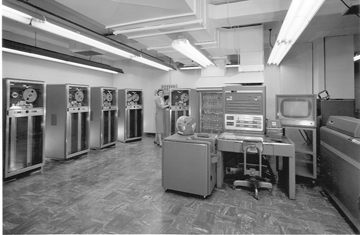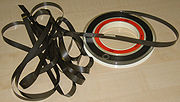
IBM 7 Track
Encyclopedia

IBM
International Business Machines Corporation or IBM is an American multinational technology and consulting corporation headquartered in Armonk, New York, United States. IBM manufactures and sells computer hardware and software, and it offers infrastructure, hosting and consulting services in areas...
's first magnetic tape data storage
Magnetic tape data storage
Magnetic tape data storage uses digital recording on to magnetic tape to store digital information. Modern magnetic tape is most commonly packaged in cartridges and cassettes. The device that performs actual writing or reading of data is a tape drive...
devices, introduced in 1952, use what is now generally known as 7 track tape. The magnetic tape
Magnetic tape
Magnetic tape is a medium for magnetic recording, made of a thin magnetizable coating on a long, narrow strip of plastic. It was developed in Germany, based on magnetic wire recording. Devices that record and play back audio and video using magnetic tape are tape recorders and video tape recorders...
is 1/2" wide and there are 6 data tracks plus 1 parity track for a total of 7 parallel tracks that span the length of the tape. Data is stored as 6-bit characters, with each bit of the character and the additional parity bit stored in a different track.
These tape drives were mechanically sophisticated floor-standing drives that used vacuum columns to buffer long U-shaped loops of tape. Between active control of powerful reel motors and vacuum control of these U-shaped tape loops, extremely rapid start and stop of the tape at the tape-to-head interface could be achieved. When active, the two tape reels thus fed tape into or pulled tape out of the vacuum columns, intermittently spinning in rapid, unsynchronized bursts resulting in visually striking action. Stock shots of such vacuum-column tape drives in motion were widely used to represent "the computer" in movies and television.
As of 2009, the Computer History Museum
Computer History Museum
The Computer History Museum is a museum established in 1996 in Mountain View, California, USA. The Museum is dedicated to preserving and presenting the stories and artifacts of the information age, and exploring the computing revolution and its impact on our lives.-History:The museum's origins...
has working IBM 729 tape drives attached to their working IBM 1401
IBM 1401
The IBM 1401 was a variable wordlength decimal computer that was announced by IBM on October 5, 1959. The first member of the highly successful IBM 1400 series, it was aimed at replacing electromechanical unit record equipment for processing data stored on punched cards...
system and is interested in reading 7-track tapes from the public. http://ed-thelen.org/1401Project/1401RestorationPage.html
Technical details

Inter-record Gap : A gap (initially one inch, later 3/4 inch) between records allowed the mechanism time to start and stop the tape.
Latency : There was only a 1.5ms delay for the stopped tape to reach its full reading or writing speed.
Markers : Aluminum strips were glued several feet from the ends of the tape to serve as logical beginning and end of tape markers.
Write protection
Write protection
Write protection is any physical mechanism that prevents modification or erasure of valuable data on a device. Most commercial software, audio and video is sold pre-protected.-Examples:...
: A removable plastic ring in the back of the tape reel was used to indicate whether writing should be permitted.
Generations
| IBM Model | 726 | 727 | 728 | 729 | 7330 |
|---|---|---|---|---|---|
| Density (chars/in) | 100 | 200 | 248 | 200, 556, 800 | 200, 556 |
| Tape speed (in/s) | 75 | 75 | 75 | 75 (112.5) |
36 |
| Transfer rate (chars/s) | 7,500 | 15,000 | 18,750 | 15,000 41,700 60,000 (22,500 62,500 90,000) |
7,200 20,016 |
| end of record gap | 1 Inch 100 chars 16.67 words |
0.75 Inches 150 chars 25 words |
0.75 Inches 186 chars 31 words |
0.75 Inches 150, 417, 600 chars 25, 69.5, 100 words |
0.75 Inches 150, 417 chars |
| Rewind speed (in/s, avg.) | 75, read backwards | 500 | 500 | ||
| Start time (msec) | 10 | 5 | 5 | ||
| Stop time (msec) | 10 | 5 | 5 | ||
| Max. length of reel (ft) | 1,400 | 2,400 | 2,400 | 2,400 | 2,400 |
| Base Composition | cellulose acetate | PET film PET film (biaxially oriented) BoPET is a polyester film made from stretched polyethylene terephthalate and is used for its high tensile strength, chemical and dimensional stability, transparency, reflectivity, gas and aroma barrier properties and electrical insulation.A variety of companies manufacture boPET and other... or cellulose acetate |
PET film or cellulose acetate |
PET film | PET film |
IBM 726
The IBM 726IBM 726
The IBM 726 dual magnetic tape reader/recorder for the IBM 701 was announced on May 21, 1952. Unlike later IBM 7 track drives, the 726 could read backwards as well as forwards....
dual magnetic tape reader/recorder for the IBM 701
IBM 701
The IBM 701, known as the Defense Calculator while in development, was announced to the public on April 29, 1952, and was IBM’s first commercial scientific computer...
was announced on May 21, 1952.
IBM 727
The IBM 727IBM 727
The IBM 727 Magnetic Tape Unit was announced for the IBM 701 and IBM 702 on September 25, 1953. It became IBM's standard tape drive for their early vacuum tube era computer systems. Later vacuum tube machines and first-generation transistor computers used the IBM 729-series tape drive...
Magnetic Tape Unit was announced for the IBM 701
IBM 701
The IBM 701, known as the Defense Calculator while in development, was announced to the public on April 29, 1952, and was IBM’s first commercial scientific computer...
and IBM 702
IBM 702
The IBM 702 was IBM's response to the UNIVAC—the first mainframe computer using magnetic tapes. Because these machines had less computational power than the IBM 701 and ERA 1103, which were favored for scientific computing, the 702 was aimed at business computing.The system used electrostatic...
on September 25, 1953. It became IBM's standard tape drive for their vacuum tube
Vacuum tube
In electronics, a vacuum tube, electron tube , or thermionic valve , reduced to simply "tube" or "valve" in everyday parlance, is a device that relies on the flow of electric current through a vacuum...
era computer systems. It was withdrawn on May 12, 1971.
IBM 728
The IBM 728IBM 728
The IBM 728 magnetic tape drive was used on the SAGE AN/FSQ-7 computer. It was physically similar to the IBM 727, but with significantly different specifications.This is one of several IBM 7 track tape drives. Tape Word Bit Positions...
magnetic tape drive was used on the SAGE AN/FSQ-7
AN/FSQ-7
The AN/FSQ-7 was a computer model developed and built in the 1950s by IBM in partnership with the US Air Force. Fifty-two were built and used for command and control functions for the Semi Automatic Ground Environment air-defense system...
computer. It was physically similar to the IBM 727
IBM 727
The IBM 727 Magnetic Tape Unit was announced for the IBM 701 and IBM 702 on September 25, 1953. It became IBM's standard tape drive for their early vacuum tube era computer systems. Later vacuum tube machines and first-generation transistor computers used the IBM 729-series tape drive...
, but with significantly different specifications.
- tracks: 6 Data, 1 synchronization
- words: 6 chars (32 data bits, 1 parity bit, 3 end of file bits)
- words/inch: 41.33
IBM 729
The IBM 729IBM 729
The IBM 729 Magnetic Tape Unit was IBM's iconic tape mass storage system from the late 1950s through the mid 1960s. Part of the IBM 7 track family of tape units, it was used on late 700, most 7000 and many 1400 series computers...
Magnetic Tape Unit was IBM's iconic tape
Magnetic tape
Magnetic tape is a medium for magnetic recording, made of a thin magnetizable coating on a long, narrow strip of plastic. It was developed in Germany, based on magnetic wire recording. Devices that record and play back audio and video using magnetic tape are tape recorders and video tape recorders...
mass storage system from the late 1950s through the mid 1960s. It was used on late 700, most 7000
IBM 700/7000 series
The IBM 700/7000 series was a series of large-scale computer systems made by IBM through the 1950s and early 1960s. The series included several different, incompatible processor architectures. The 700s used vacuum tube logic and were made obsolete by the introduction of the transistorized 7000s...
and many 1400
IBM 1400 series
The IBM 1400 series were second generation mid-range business decimal computers that IBM sold in the early 1960s. They could be operated as an independent system, in conjunction with IBM punched card equipment, or as auxiliary equipment to other computer systems.1400-series machines stored...
series computers. A new dual gap head assembly allowed read-after-write verification.
IBM 7330
The IBM 7330IBM 7330
The IBM 7330 Magnetic Tape Unit was IBM's low cost tape mass storage system through the 1960s. Part of the IBM 7 track family of tape units, it was used mostly on 1400 series computers...
Magnetic Tape Unit was a low cost slower tape system. It was common on 1400
IBM 1400 series
The IBM 1400 series were second generation mid-range business decimal computers that IBM sold in the early 1960s. They could be operated as an independent system, in conjunction with IBM punched card equipment, or as auxiliary equipment to other computer systems.1400-series machines stored...
series computers.
IBM 2400 Series
The 2400 Series Magnetic Tape Units were introduced with the System/360. Most were IBM 9 TrackIBM 9 Track
The IBM System/360, released in 1964, introduced what is now generally known as 9 track tape. As with the earlier IBM 7 track format it replaced, the magnetic tape is ½ inch wide, but has 8 data tracks and one parity track for a total of 9 parallel tracks. Data is stored as 8-bit characters,...
format drives, but they could be ordered with 7 track read/write heads, allowing them to read and write 7 track tapes.
Sources
- IBM 726 Magnetic tape reader/recorder
- IBM 727 Magnetic tape unit
- Bitsavers.org Magnetic Tape Equipment manuals (PDF files)
- A22-6589-1_magTapeReference_Jun62.pdf – Reference manual for 7 track drives
- IBM 727 Magnetic tape unit (photo) Sold with 705 in 1955.

